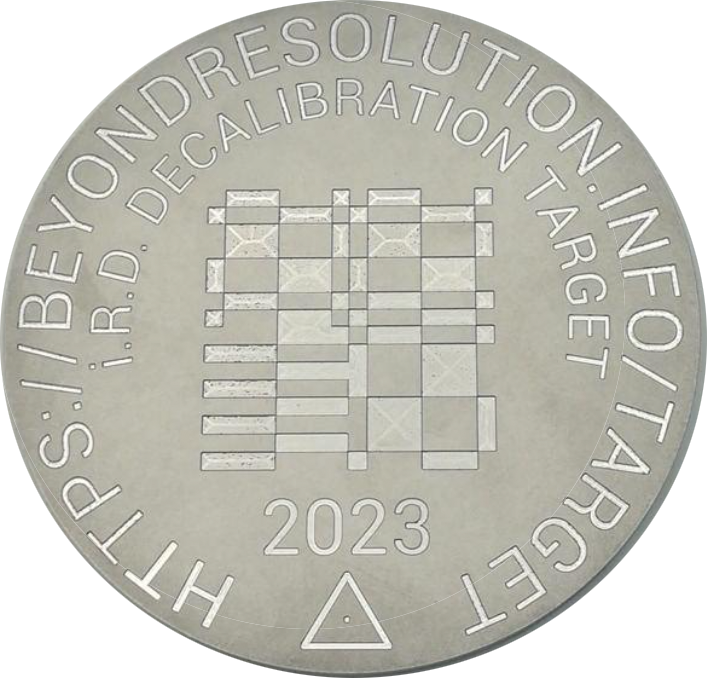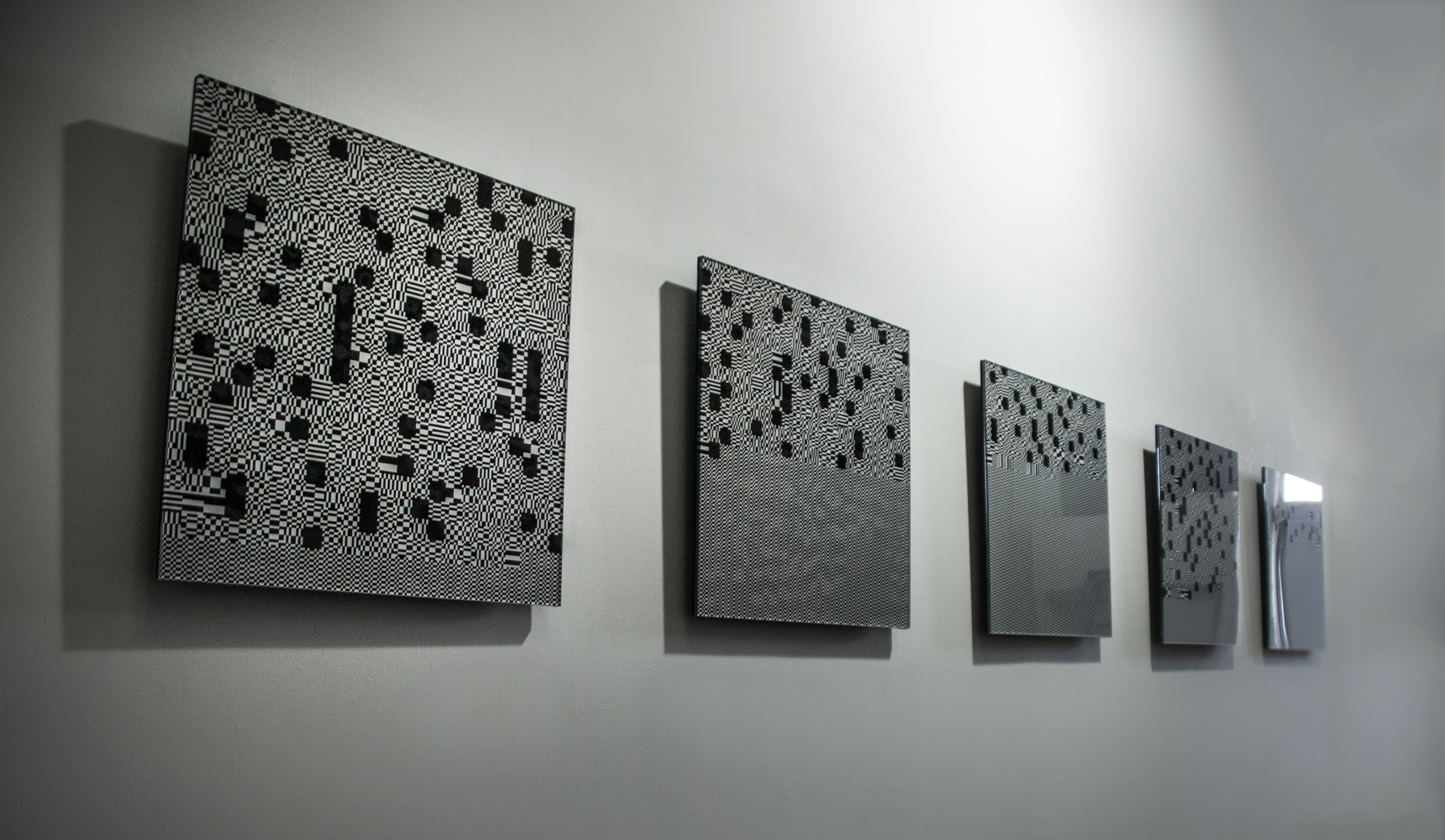
DE/CALIBRATION TARGET
&& DCT REPO
HOW NOT
TO BE READ.PDF
▣⬓⬒◨◧
DCT ENCRYPTION
STATION
◨◧◧⬓◨
DCT GENEALOGIES
◧⬒◨◧⬓
![]()
IM/POSSIBLE IMAGES
◧⬒◨⬓◧
DE/CALIBRATION
ARMY
◧⬒◨⬓◧
SHREDDED HOLOGRAM ROSE
◨◧◧⬓◨
TO BE READ.PDF
▣⬓⬒◨◧
DCT ENCRYPTION
STATION
◨◧◧⬓◨
DCT GENEALOGIES
◧⬒◨◧⬓

IM/POSSIBLE IMAGES
◧⬒◨⬓◧
DE/CALIBRATION
ARMY
◧⬒◨⬓◧
SHREDDED HOLOGRAM ROSE
◨◧◧⬓◨
 “everywhere we imagined ourselves standing turned into a cliche beneath our feet”
“everywhere we imagined ourselves standing turned into a cliche beneath our feet”– Naomi Klein, No logo, 1999.
A publication in five acrylics / five postcards.
Even though the i.R.D. mimic an institute, in reality it is not a classic, institutional organ. Instead, the i.R.D. multiplexes the term institution, by revisiting its usage in the late 1970s. In this context, formulated by Joseph Goguen and Rod Burstall, institution refers to a slightly ‘more compound framework’, that deals with the growing complexities, connecting different logical systems (such as databases and programming languages) within computer sciences. A main result of these non-logical institutions is that different logical systems can be glued together at a substrata level, forming illogical frameworks through which computation also takes place.
Inspired by the idea of hyper functional, yet illogical frameworks, the i.R.D. is dedicated to researching the interests of anti-utopic, obfuscated, lost and unseen, or simply ‘too good to be implemented’ resolutions.
The institutions of Resolution Disputes [i.R.D.] call attention to media resolutions. While a resolution generally simply refers to a determination of functional settings in the technological domain, the i.R.D. stresses that a resolution is indeed a settlement (solution), but at the same time also entails a space of compromise between different actors (objects, materialities, and protocols) in dispute over norms (frame rate, number of pixels etc.). Common settings can ossify as generally accepted requirements or de facto standards, while others standards are notated as norms by standardizing organizations such as the International Organization for Standardization. We call this progress*.
Resolutions are non-neutral standard settings that involve political, economical, technological and cultural values and ideologies, embedded in the genealogies and ecologies of our media. In an uncompromisingly fashion, quality (fidelity) speed (governed by efficiency) volume (generally encapsulated in tiny-ness for hardware and big when it comes to data) and profit (economic or ownership) have been responsible for plotting the vector of progress. This dogmatic configuration of belief x action has made upgrade culture a great legitimizer of violence, putting its insufficient technological resolutions to rest. While a resolution can thus be understood as a manifold assemblage of common, but contestable standards, it should also be considered in terms of other options; those that are unknown and unseen, obsolete and unsupported.
.
Resolutions inform both machine vision and human ways of perception. They shape the material of everyday life ubiquitously. As the media landscape becomes more and more compound, or in other words, an heterogenous assemblage in which one technology never functions on its own, its complexities have moved beyond a fold of everyday settings. Technological standards have compiled into resolution clusters; media platforms that form resolutions like tablelands, flanked by steep cliffs and precipices looking out over obscure, incremental abysses that seem to harbor a mist of unsupported, obsolete norms.
The platforms of resolution now organize perspective. They are the legitimizers of both inclusion and exclusion of what can not be seen or what should be done, while the fog, the other possibilities become more and more obscure.
It is important to realize that the resolutions platforms are not inherently Evil*. They can be impartial. It is important that we unpack these resolutions and note that they are conditioning our perception. A culture that adheres to only one or few platforms of resolutions supports nepotism amongst standards. These clusters actively engage simpleness and mask the issues at stake, savoring stupidity, and are finally bound to escalate into glutinous tech-fascism.
The question is, have we become unable to construct our own resolutions, or have we become oblivious to them?
Resolutions work not just as an interface effect* but as hyperopic lens, obfuscating any other possible alternative resolutions from the users screens and media literacy. When we speak about video, we only ever refer to a four cornered moving image. Why do we not consider video with more or less corners, timelines, or soundtracks. Fonts are monochrome; they do not come with their own textures, gradients or chrominance and luminance mapping. Text editors still follow the lay-out of paper; there is hardly any modularity within written word technologies. Even ghosts, the figments of our imagination, have been conditioned to communicate exclusively through analogue forms of noise (the uncanny per default), while aliens communicate through blocks and lines (the more intelligent forms of noise). We are hiking the resolution platforms comfortably. Unknowingly suffering from technological hyperopia, We have lost track of the compromises that are at stake inside our resolutions and are staring at the screens showing us mirage after mirage.
A resolution is the lens through which constituted materialities become signifiers in their own right. They resonate the tonality of the hive mind and constantly transform our technologies into informed material vernaculars.
Technology is evolving faster than we, as a culture can come to terms with. This is why determinations such as standards are dangerous; they can preclude the alternative. The radical digital materialist believes in informed materiality*: while every string of data is ambiguously fluid and has the potential to be manipulated into anything, every piece of information functions within /*adhesive/ encoding, contextualization and embedding. Different forms of ossification slither into every crevice of private life, while unresolved, ungoverned free space seems to be slipping away. There lies the power of standardization.
We are in need for a re-(Re-)Distribution of the Sensible.
The i.R.D. offers a liminal space for resolution studies. Resolution studies is not only about the effects of technological *progress or about the esthetization of the scales of resolution. Resolution studies is a studies on how resolution embeds the tonalities of culture, in more than just its technological facets.
Resolution studies researches the standards that could have been in place, but are not. As a form of vernacular resistance, based on the concept of providing ambiguous resolutions, the i.R.D. employs the liminal resolution of the screen as a looking-glass. Here, hyperopia is fractured and gives space to myopia, and visa versa. This is how i.R.D. exposes the colors hidden inside the grey mundane objects* of everyday life.
The i.R.D. is not a Wunderkammer for dead media*, but a foggy bootleg trail for vernacular resistance.
Progress has fathered many dead technologies. A Wunderkammer, or curiosity cabinet of media resolutions would celebrate these dead objects by trapping them inside a glass bell, relieving them in-definitely of their action radius. While the i.R.D. adheres to the settlements of governing media resolutions, it also welcomes ventures along the bootleg trails of the tactical undead*. These undead move beyond resolution, through the literacies of the governing techno cultures, into liminal spaces. They follow the wild and uncanny desire paths that cut through sensitive forms and off-limit areas into speculative materialities*. They threaten the status quo of secure forms of media and provide the ambiguity that is so necessary for inspiration, action and curiosity*.
The i.R.D. believes that methods of creative problem creation* can bring authorship back to the layer of resolution setting. Resolution theory moves against what sometimes seems like an unsolvable puzzle of flattening reality, while the i.R.D. might seem like a one way trail straight into the Sea of Fog and towards the abyss of techno-norms. But it could also be a modular framework that opens and expands standards through inspection and reflection. As any good theory of media, resolution theory is a theory on literacy. Literacy of the machines, the people, the people creating the machines and the people being created by the machines. Through challenging the platforms of resolution, it can help the wanderer to scale actively between these states of hyperopia and myopia. It can uncover crystal cities of fog as well as shine a light on the soon to be distributed futures. Here we can mine for the timonds.

The question is, ‘have we become unable to construct our own resolutions, or have we become oblivious to them?’ Either way we are in need for another re-“(Re-)Distribution of the Sensible”.
.
![]()
i.R.D. intend to impose methods of “creative problem creation” to bring authorship back to the layer of setting a 'resolution'. The radical digital materialist believes in an “informed materiality”; while every string of data is ambiguously fluid and has the potential to be manipulated into anything, every piece of information functions within /adhesive*/ encoding, contextualization and embedding (etc).
.
![]()
Through i.R.D.s tactics beyond resolution, the otherwise grey mundane objects of everyday-life show their colors. i.R.D. is not a wunderkabinet of dead media, but a foggy bootleg trails for vernacular resistance.
▣▣▣▣▣▣▣▣▣▣▣▣.

i.R.D. intend to impose methods of “creative problem creation” to bring authorship back to the layer of setting a 'resolution'. The radical digital materialist believes in an “informed materiality”; while every string of data is ambiguously fluid and has the potential to be manipulated into anything, every piece of information functions within /adhesive*/ encoding, contextualization and embedding (etc).
.

Through i.R.D.s tactics beyond resolution, the otherwise grey mundane objects of everyday-life show their colors. i.R.D. is not a wunderkabinet of dead media, but a foggy bootleg trails for vernacular resistance.
